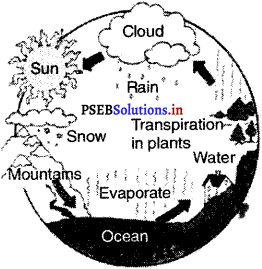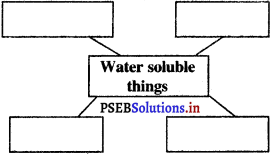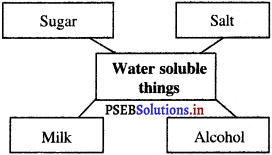Punjab State Board PSEB 5th Class EVS Book Solutions Chapter 17 Water – A Valuable Natural Source Textbook Exercise Questions and Answers.
PSEB Solutions for Class 5 EVS Chapter 17 Water – A Valuable Natural Source
EVS Guide for Class 5 PSEB Water – A Valuable Natural Source Textbook Questions and Answers
Textbook Page No. 110
Question 1.
What are the three forms of water?
Answer:
Solid, liquid, gas.
![]()
Question 2.
Which gases mix to form water?
Answer:
Oxygen and Hydrogen.
Activity 1
Take a piece of used cloth. Wet it with water. Wipe the floor with this wet piece of cloth. Leave the floor as it is. After a while, you will see that the wet floor has dried. Think, where the water has gone from the floor.
Answer:
Water evaporated.
Activity 2
Take a glass of water and put some cubes of ice in it. After sometime you will notice that drops of water appear on the outer surface of glass. Can you tell where these drops of water have come from.
Answer:
Water vapours present in air condense after touching the cold outer surface of the glass and form drops of water on the outer surface of glass.
![]()
Textbook Page No. 111
Activity 3
Take a glass of water in a pan. Mix two spoons of salt in it. Now separate the salt from water.
Answer:
Heat this water in a frying pan or in a china dish, when water completely evaporates salt is left in the container. We can also get salt if we place the container in sun for sorne days.
Textbook Page No. 113
Question 1.
Fill in the blanks : (three, blue, cloud, ice)
(i) Water has forms.
(ii) Evaporated water becomes a
(iii) Because of water, earth is called a planet.
(iv) Solid form of water is called
Answer:
(i) three,
(ii) cloud,
(iii) blue,
(iV) ice.
Question 2.
Tick (✓) the correct and cross (✗) the wrong sentences :
(i) Condensed water changes into vapour.
(ii) Pure water has no colour.
(iii) In old days many people were not allowed to get water due to caste-based discrimination.
(iv) Water cycle goes on continuously.
Answer:
(i) F,
(ii) T,
(iii) T,
(iv) T.
![]()
Question 3.
Tick (✓) the correct answers :
(i) At what temperature does water turn into ice?
(a) 40°C
(b) o°c
(c) 100°C
Answer:
(b) o°c
(ii) What is the %age of water on earth?
(a) 60%
(b) 50%
(c) 70%
Answer:
(c) 70%
(iii) What dissolves into water?
(a) Salt
(b) Sand
(c) Stones
Answer:
(a) Salt
![]()
(iv) What does not sink into water 7
(a) Iron
(b) Stones
(c) Wood
Answer:
(c) Wood
(v) Which gas mixes with oxygen to form water?
(a) Carbon dioxide
(b) Nitrogen
(c) Hydrogen
Answer:
(c) Hydrogen
Question 4.
Write the name of three things that sink into water.
Answer:
Stone, iron, sand.
Textbook Page No. 114
Question 5.
Write the name of three things that float on water.
Answer:
Plastic, wood, thermocol.
![]()
Question 6.
Write the names of three things that dissolve into water.
Answer:
Salt, sugar, milk.
Question 7.
List the properties of pure water.
Answer:
- Pure water has no colour .
- It has no taste.
- It has no smell, no shape.
Question 8.
What is water cycle? Explain with a figure.
Answer:
All the water sources like sea, rivers, lakes, etc. get heated and water evaporates and vapours make clouds. When clouds become heavy, rain or snowfall begins. Water again reaches into the rivers etc. and finally into the sea.

![]()
Textbook Page No. 115
Question 9.
How can the dissolved salt be separated from water?
Answer:
Heat the solution and boil it, continue heating till all the water evaporates and only salt remains in the container.
Question 10.
What is evaporation? Give some examples.
Answer:
When water is left open, tiny ‘ particles of water evaporate in air, this process is called evaporation, e.g. when we wipe out floor using a wet cloth, the floor dries soon due to evaporation.
Question 11.
When does a thing float on water?
Answer:
When things or objects displace more water than their weight, things float on water.
PSEB 5th Class EVS Guide Water – A Valuable Natural Source Important Questions and Answers
1. Tick the correct option :
(i) Properties of water are :
(a) colourless
(b) odourless
(c) shapeless
(d) all correct.
Answer:
(d) all correct.
![]()
(ii) Water in compound formed by joining oxygen and
(a) nitrogen
(b) carbon dioxide
(c) helium
(d) hydrogen
Answer:
(b) carbon dioxide
2. Answer in one/two lines :
Question 1.
What is water recharging?
Answer:
When land dug deeply and rain water filled in it. This water went in to land. This process is called water recharging.
Question 2.
Water is cooled upto zero degree cckius, what change will take place?
(From Board M.QuestionP.)
Answer:
Water is cooled upto zero degree celcius than it will change into ice.
![]()
3. Fill in the blanks :
(i) On heating, water changes into ………………………….
(ii) Solid form of water is ………………………….
(iii) Vapours condense to form ………………………….
Answer:
(i) vapour,
(ii) ice,
(iii) drops.
4. Truc/False :
(i) Pure water has no colour.
(ii) Water has four forms.
(iii) Stone is insoluble in water.
(iv) Fish, like crocodile can live on ground also.
(v) In olden days many people were not allowed to drink water due to caste based discrimination.
Answer:
(i) T
(ii) F
(iii) T
(iv) F
(v) T.
![]()
5. Match the following column :
(i) ice – (a) 100°C
(ii) clouds – (b) cooling
(iii) evaporation – (c) 0°C
(iV) boiling water – (d) steam.
Answer:
(i) (c)
(ii) (d)
(iii) (b)
(iv) (a)
6. Mind Map

Answer:

7. Answer in five/six lines :
Question 1.
What do you know about condensation of water ?
Answer:
Air always have water vapours in it. When temperature decreases these vapours condense into water droplets. This process of conversion of water vapours into water droplets is known as condensation. We can see water droplets on the outer side of a glass filled with cold water. Dew drops seen on the surface of leaves in winter is also example of condensation of water.
![]()
Question 2.
In your class, your teacher added ice pieces in a glass half-filled with water. After some time we see small drops of water outside the glass, from where these drops come?
Answer:
Ice water becomes colder than the surrounding air. Water vapours present in air come in contact with glass surface and get condensed to become water drops.